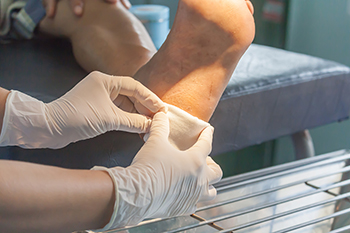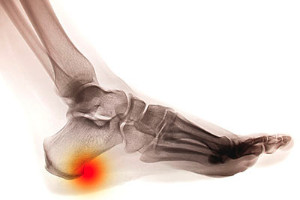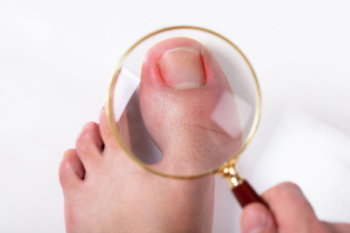Connect With Us
Blog
Items filtered by date: July 2024
Understanding Plantar Fibromatosis and Ledderhose Disease

Plantar fibromatosis and Ledderhose disease are related conditions characterized by the development of benign nodules or lumps in the connective tissue of the feet, affecting the plantar fascia and foot arch. These nodules, composed of fibrous tissue, can cause pain and discomfort, particularly while standing or walking. Plantar fibromatosis typically affects the middle of the foot's underside, while Ledderhose disease occurs on the underside of the foot arch. These conditions often cause a feeling of pressure or a sensation akin to walking on pebbles. While symptoms can vary, they generally worsen with weight-bearing activities due to the increased pressure on the affected areas. Relief options include orthotic devices, steroid injections, and in severe cases, surgical removal of the nodules to alleviate pain and restore foot function. If you have nodules or lumps on the bottom of your foot, it is suggested that you consult a podiatrist who can accurately diagnose and treat these conditions.
A plantar fibroma may disrupt your daily activities. If you have any concerns, contact Dr. Nicholas Przystawski of Central Florida Foot Care, PA. Our doctor can provide the care you need to keep you pain-free and on your feet.
Plantar Fibroma
A plantar fibroma is a fibrous knot in the arch of the foot. It is embedded in the plantar fascia which is a band of tissue that extends from the heel to the toes along the bottom of the foot. There can be multiple plantar fibromas in the feet at the same time. There are no known causes for this condition. If you have a plantar fibroma, there will be a bump in the arch of your foot that cannot be missed. Any associated pain is most often due to a shoe rubbing against the nodule. Non-surgical options, such as steroid injections, physical therapy, and orthotics should be tried first. Surgery is a last resort and is the only thing that will remove a plantar fibroma entirely. Consult with a podiatrist for a proper diagnosis and to determine the treatment regimen that is right for you.
What Causes a Plantar Fibroma?
While there are no specific causes identified, a plantar fibroma can possibly come from genetic predisposition or the formation of scar tissue that forms from healing the tears in the plantar fascia.
What Are the Symptoms of a Plantar Fibroma?
There will be a noticeable lump in the arch of the foot that may or may not cause pain. If pain is felt, it is typically because a shoe is rubbing up against the lump or when walking or standing barefoot.
Treatment and Prevention
A plantar fibroma will not disappear without treatment, but it can get smaller and be a non-issue. If pain persists, a podiatrist examines the foot and when the arch of the foot is pressed, pain can be felt down to the toes. An MRI or biopsy might be performed to help diagnose or evaluate the plantar fibroma. The following non-surgical options are generally enough to reduce the size and pain of these nodules:
- Steroid injections
- Orthotics
- Physical therapy to help apply anti-inflammatory creams on the bump
Surgery is considered if the mass increases in size and the patient continues to feel pain after non-surgical methods are tried.
If you have any questions please feel free to contact our office located in Leesburg, FL . We offer the newest diagnostic tools and technology to treat your foot and ankle needs.
Effective Strategies for Relieving Gout Pain

Gout is a form of arthritis characterized by sudden, severe attacks of pain, redness, and swelling in joints, often caused by an excess of uric acid in the blood. Relieving gout pain involves a combination of medication and lifestyle changes. Nonsteroidal anti-inflammatory drugs, corticosteroids, and colchicine can help reduce inflammation and alleviate pain. Staying well-hydrated by drinking plenty of water can help to flush uric acid from the body, potentially preventing future attacks. Resting the affected joint and keeping it elevated can also provide relief. Dietary changes, such as reducing intake of purine-rich foods like red meat, shellfish, and alcohol, may help to lower uric acid levels. Consuming cherries or cherry juice has been shown to reduce gout flare-ups. Maintaining a healthy weight through regular exercise and a balanced diet can further help manage gout symptoms. Gout can severely hinder daily life. If you have had one or more gout attacks, it is strongly suggested that you are under the care of a podiatrist who can offer you effective relief and treatment strategies.
Gout is a painful condition that can be treated. If you are seeking treatment, contact Dr. Nicholas Przystawski from Central Florida Foot Care, PA. Our doctor will treat your foot and ankle needs.
What Is Gout?
Gout is a form of arthritis that is characterized by sudden, severe attacks of pain, redness, and tenderness in the joints. The condition usually affects the joint at the base of the big toe. A gout attack can occur at any random time, such as the middle of the night while you are asleep.
Symptoms
- Intense Joint Pain - Usually around the large joint of your big toe, and it most severe within the first four to twelve hours
- Lingering Discomfort - Joint discomfort may last from a few days to a few weeks
- Inflammation and Redness -Affected joints may become swollen, tender, warm and red
- Limited Range of Motion - May experience a decrease in joint mobility
Risk Factors
- Genetics - If family members have gout, you’re more likely to have it
- Medications - Diuretic medications can raise uric acid levels
- Gender/Age - Gout is more common in men until the age of 60. It is believed that estrogen protects women until that point
- Diet - Eating red meat and shellfish increases your risk
- Alcohol - Having more than two alcoholic drinks per day increases your risk
- Obesity - Obese people are at a higher risk for gout
Prior to visiting your podiatrist to receive treatment for gout, there are a few things you should do beforehand. If you have gout you should write down your symptoms--including when they started and how often you experience them, important medical information you may have, and any questions you may have. Writing down these three things will help your podiatrist in assessing your specific situation so that he or she may provide the best route of treatment for you.
If you have any questions, please feel free to contact our office located in Leesburg, FL . We offer the newest diagnostic and treatment technologies for all your foot care needs.
Diagnosis and Symptoms of Foot Puncture Wounds

Foot puncture wounds are injuries where a sharp object pierces the skin and underlying tissues of the foot. These wounds can occur from stepping on nails, glass, or other sharp objects. Proper diagnosis involves a physical examination by a podiatrist, often accompanied by imaging tests like X-rays to assess the depth and presence of foreign objects. Symptoms of a foot puncture wound include pain, swelling, redness, and bleeding at the site of injury. If the wound becomes infected, additional symptoms such as warmth, pus, and increased pain may develop. Timely medical attention is vital to clean the wound thoroughly, prevent infection, and ensure proper healing. If you have stepped on a sharp object and have developed a foot wound, it is suggested that you seek prompt medical treatment from a podiatrist who can effectively manage this condition.
Wound care is an important part in dealing with diabetes. If you have diabetes and a foot wound or would like more information about wound care for diabetics, consult with Dr. Nicholas Przystawski from Central Florida Foot Care, PA. Our doctor will assess your condition and provide you with quality foot and ankle treatment.
What Is Wound Care?
Wound care is the practice of taking proper care of a wound. This can range from the smallest to the largest of wounds. While everyone can benefit from proper wound care, it is much more important for diabetics. Diabetics often suffer from poor blood circulation which causes wounds to heal much slower than they would in a non-diabetic.
What Is the Importance of Wound Care?
While it may not seem apparent with small ulcers on the foot, for diabetics, any size ulcer can become infected. Diabetics often also suffer from neuropathy, or nerve loss. This means they might not even feel when they have an ulcer on their foot. If the wound becomes severely infected, amputation may be necessary. Therefore, it is of the upmost importance to properly care for any and all foot wounds.
How to Care for Wounds
The best way to care for foot wounds is to prevent them. For diabetics, this means daily inspections of the feet for any signs of abnormalities or ulcers. It is also recommended to see a podiatrist several times a year for a foot inspection. If you do have an ulcer, run the wound under water to clear dirt from the wound; then apply antibiotic ointment to the wound and cover with a bandage. Bandages should be changed daily and keeping pressure off the wound is smart. It is advised to see a podiatrist, who can keep an eye on it.
If you have any questions, please feel free to contact our office located in Leesburg, FL . We offer the newest diagnostic and treatment technologies for all your foot care needs.
Causes and Prevention of Heel Spurs

Heel spurs are calcium deposits that develop on the underside of the heel bone, often without causing any discomfort. However, when the plantar fascia ligament, which connects the heel to the toes, undergoes excessive tension or strain, it can become inflamed. This may lead to a condition known as plantar fasciitis, which can cause the heel spur to press into the swollen ligament and cause significant pain. While heel spurs themselves are generally painless, they frequently accompany plantar fasciitis, with about 70 percent of cases showing the presence of a heel spur. Preventative measures include wearing shoes with proper arch support, using heel pads, maintaining a healthy weight, and performing calf stretches before engaging in strenuous activities. A podiatrist can provide a comprehensive treatment plan tailored to your specific needs, which may include custom orthotics, physical therapy, and recommendations for supportive footwear. Surgery may be needed to address severe cases, though it carries risks such as increased pain, nerve damage, and fallen arches. If you are experiencing heel pain, it is suggested that you make an appointment with a podiatrist for an exam and treatment.
Heel spurs can be incredibly painful and sometimes may make you unable to participate in physical activities. To get medical care for your heel spurs, contact Dr. Nicholas Przystawski from Central Florida Foot Care, PA. Our doctor will do everything possible to treat your condition.
Heels Spurs
Heel spurs are formed by calcium deposits on the back of the foot where the heel is. This can also be caused by small fragments of bone breaking off one section of the foot, attaching onto the back of the foot. Heel spurs can also be bone growth on the back of the foot and may grow in the direction of the arch of the foot.
Older individuals usually suffer from heel spurs and pain sometimes intensifies with age. One of the main condition's spurs are related to is plantar fasciitis.
Pain
The pain associated with spurs is often because of weight placed on the feet. When someone is walking, their entire weight is concentrated on the feet. Bone spurs then have the tendency to affect other bones and tissues around the foot. As the pain continues, the feet will become tender and sensitive over time.
Treatments
There are many ways to treat heel spurs. If one is suffering from heel spurs in conjunction with pain, there are several methods for healing. Medication, surgery, and herbal care are some options.
If you have any questions feel free to contact our office located in Leesburg, FL . We offer the latest in diagnostic and treatment technology to meet your needs.
Why Live with Pain and Numbness in Your Feet?
Ingrown Toenail Management
 An ingrown toenail occurs when the edge of a toenail grows into the surrounding skin, causing pain, swelling, and sometimes infection. This condition is often seen in the big toe and can result from improper nail trimming, wearing tight footwear, or injury to the toe. When the nail pierces the skin, it creates an entry point for bacteria, leading to redness, pain, and pus formation. Managing an ingrown toenail involves soaking the affected foot in warm water to reduce swelling, gently lifting the nail edge, and applying antibiotic ointment. It is important to avoid cutting the nail too short or rounding the corners, as this can worsen the condition. Complications from untreated ingrown toenails can include severe infections, abscess formation, and in extreme cases, bone infections. To prevent ingrown toenails, trim nails straight across, wear properly fitting shoes, and maintain good foot hygiene. If the condition persists or worsens, it is suggested that you
An ingrown toenail occurs when the edge of a toenail grows into the surrounding skin, causing pain, swelling, and sometimes infection. This condition is often seen in the big toe and can result from improper nail trimming, wearing tight footwear, or injury to the toe. When the nail pierces the skin, it creates an entry point for bacteria, leading to redness, pain, and pus formation. Managing an ingrown toenail involves soaking the affected foot in warm water to reduce swelling, gently lifting the nail edge, and applying antibiotic ointment. It is important to avoid cutting the nail too short or rounding the corners, as this can worsen the condition. Complications from untreated ingrown toenails can include severe infections, abscess formation, and in extreme cases, bone infections. To prevent ingrown toenails, trim nails straight across, wear properly fitting shoes, and maintain good foot hygiene. If the condition persists or worsens, it is suggested that you
Ingrown toenails may initially present themselves as a minor discomfort, but they may progress into an infection in the skin without proper treatment. For more information about ingrown toenails, contact Dr. Nicholas Przystawski of Central Florida Foot Care, PA. Our doctor can provide the care you need to keep you pain-free and on your feet.
Ingrown Toenails
Ingrown toenails are caused when the corner or side of a toenail grows into the soft flesh surrounding it. They often result in redness, swelling, pain, and in some cases, infection. This condition typically affects the big toe and may recur if it is not treated properly.
Causes
- Improper toenail trimming
- Genetics
- Improper shoe fitting
- Injury from pedicures or nail picking
- Abnormal gait
- Poor hygiene
You are more likely to develop an ingrown toenail if you are obese, have diabetes, arthritis, or have any fungal infection in your nails. Additionally, people who have foot or toe deformities are at a higher risk of developing an ingrown toenail.
Symptoms
Some symptoms of ingrown toenails are redness, swelling, and pain. In rare cases, there may be a yellowish drainage coming from the nail.
Treatment
Ignoring an ingrown toenail can have serious complications. Infections of the nail border can progress to a deeper soft-tissue infection, which can then turn into a bone infection. You should always speak with your podiatrist if you suspect you have an ingrown toenail, especially if you have diabetes or poor circulation.
If you have any questions, please feel free to contact our office located in Leesburg, FL . We offer the newest diagnostic and treatment technologies for all your foot care needs.

